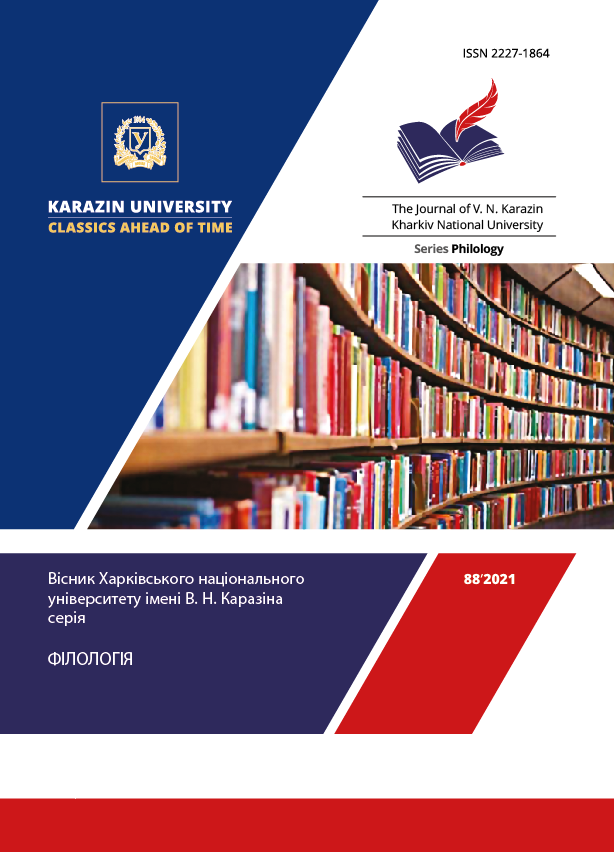So Imagism Began
Abstract
The paper aims at exploring the importance of the first period of Imagism development in the twentieth-century literary history. Turning our mind to the dawn of Imagism is important because the analysis of its first stage helps uncover the main goal of the research – to prove that the short success history and the long-term influence of Imagism on the twentieth-century English-language poetry and lyrical narrative history have been rooted both in the practical “behaviour rules” for the new poetry and in the complex aesthetic debate with the previous tradition – Classicism, Romanticism and Symbolism.
The new focus of the research is the investigation of “The Poets’ Club” (T. E. Hulme, F. Flint et al.) and particularly Edward Storer’s activity in Imagist theory and practice elaboration. This aspect of the paper adjusts and deepens the generally accepted point of view on the Ezra Pound’s decisive role in shaping the movement being the only “impresario” of Imagism and Modernism. T. E. Hulme’s ideas of breaking with the Romantic aesthetics for the Classicist one; substituting metaphor with analogy; focusing on particular physical image ((“Lecture on Modern Poetry”, 1908; “Romanticism and Classicism”, 1911) were supported by Edward Storer. The search for new verse poetics denying the absolute imperative of syllabic tonics, artificial rhythm and rhyme, was also common. First imagists’ theoretical views review is backed up with the analysis of Hulme’s (“Autumn”, “Embankment”, “Conversion”) and Storer’s (“Illusion”, “Image”, “By the Shore”) poems on the background of Romantic and Georgian poetry.
It’s hardly possible to over-estimate the role of T. E. Hulme, F. Flint, E. Storer and “The Poets’ Club” in Imagism making as they were not just proclaiming the new relations “author/persona – text/image – reader” but also exhibiting the concern for the receptive side of poetry; new objectiveness instead of Romantic abstraction; impersonality, technical freedom and “new symbolism” found in “small dry images”.
Downloads
References
Antologiya imazhizma (2001). Per.s angl. i predisl. A. Kudryavitskogo. Moskva: Progress. URL: http://kudryavitsky.narod.ru/ imagists.html (data zvernennia 26.09.2020). [in Russian]
Literaturoznavchyi slovnyk-dovidnyk (1997) / R. T. Grom’yak, Y. I. Kovaliv ta in. Кyiv: «Аkademiya». [in Ukrainian]
Reingold N. I. (2017). Аngliyskaya literature modernisma. Мoskva: RGGU [in Russian]
Filosofskyi encyclopedicheskyi slovar’ (1989). Sovetskaya entsyklopediya. [in Russian]
Chernokova Ye. S. (2013) Angliys’ka liryka 1900–1920 rokiv I stanovlennya modernizmy. Kharkiv: Kompaniya СМІТ. [in Ukrainian]
Broom (1922 ): An International Magazine of Arts. Vol. 2. Number 3. June 1922 // Blue Mountain Project: Historic Avant-Garde Periodicals for Digital Research. URL: bluemountain.princeton.edu/bluemtn/ ?a=d&d=bmtnaap192206-01.2.25& (Princeton University Library) (data zvernennia 26.09.2020). [in English]
Carr H. (2003). Imagism: A Hundred Years On. Imagism: Essays on Its Initiation, Impact and Influence. New Orleans: University of New Orleans Press. [in English]
The Complete Poetical Works of T. E. Hulme (1991) // Pound E. Personæ: Collected Shorter Poems. Lnd. – N.Y.: Faber and Faber. [in English]
The Complete Poetical Works of William Cowper (1905). Ed. H. S. Milford. Lnd: Henry Frowde. [in English]
Daiches D (1970). A Critical History of English Literature. Vol. II. N. Y.: The Ronald Press Company. [in English]
Eliot T. S. (1997). Tradition and Individual Talent // Eliot T. S. The Sacred Wood: Essays on Poetry and Criticism. London: Faber and Faber Ltd. [in English]
Flint F. (1915). The History of Imagism// The Egoist: An Individualist Review. No.5. Vol. II. May 1st,. Pp. 70–71. URL: https://modjourn.org/issue/ bdr521317/ (data zvernennia 26.09.2020). [in English]
Hadjiyiannis С. (2003). Ezra Pound, T. E. Hulme, Edward Storer: Imagism as Anti-Romanticism in the Pre-Des Imagistes Era // Imagism: Essays on Its Initiation, Impact and Influence; [ed. John Gery, Daniel Kempton, H. R. Stoneback]. New Orleans: University of New Orleans Press. [in English]
Hulme T. E. (2017) Romanticism and Classicism // Рейнгольд Н. И. Английская литература модернизма: История. Проблематика. Поэтика. Москва: РГГУ. [in English]
Kenner H. (1951). The Poetry of Ezra Pound. Lnd.: Faber and Faber. [in English]
The Oxford Companion to Twentieth-Century Literature in English (1996). Oxford, N.Y.: Oxford UP. [in English]
Perkins D. (1976). A History of Modern Poetry: From the 1890s to the High Modernist Mode. Cambridge, Lnd.: The Belknap Press of Harvard UP. [in English]
Selected Poetry of the First World War (1995). Lnd: Wordsworth Editions Ltd. [in English]
Storer E. (1908). “An Essay”// Storer E. Mirrors of Illusion. London: Sisley’s. [in English]
Witemayer H. (2003). Modernism and the Transatlantic Connection // A Companion to Twentieth-Century Poetry. Blackwell Publishing Ltd. [in English]




